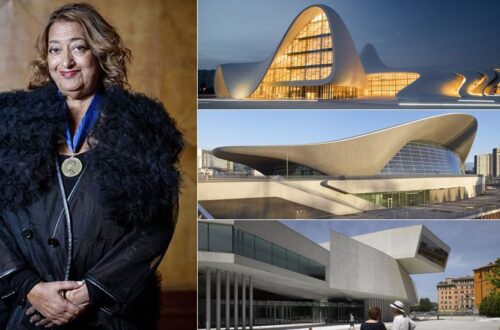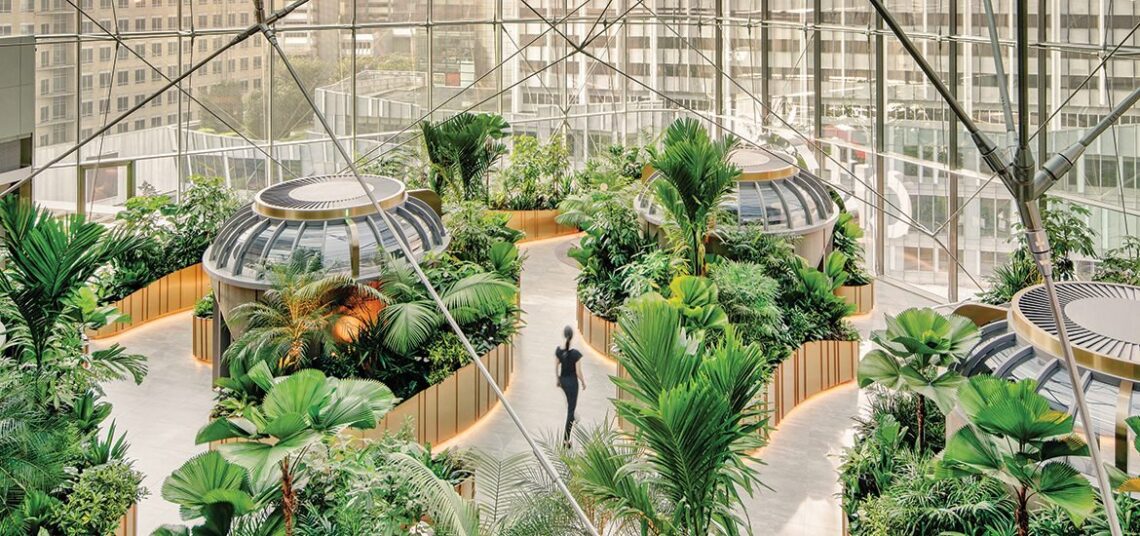
The Rise of Biophilic Design: How It Is Reshaping Urban Architecture
In short terms, biophilic design is defined as an approach to architecture that seeks to connect building occupants more closely with nature. The concept of biophilic stems from the Greek word, biophilia: ‘bio’ meaning ‘life’ and ‘philia’ meaning the ‘love of’. Strictly, it literally means the love of life or living things, which is the guiding principle behind biophilic design. By integrating nature into our architecture, it enhances our connection with the natural world and contributes to the health and well-being of the occupants. In this article, you will discover the rise of biophilic design, its benefits, embracing elements and how it is reshaping our society.
The Origins & Rise of Biophilic Design
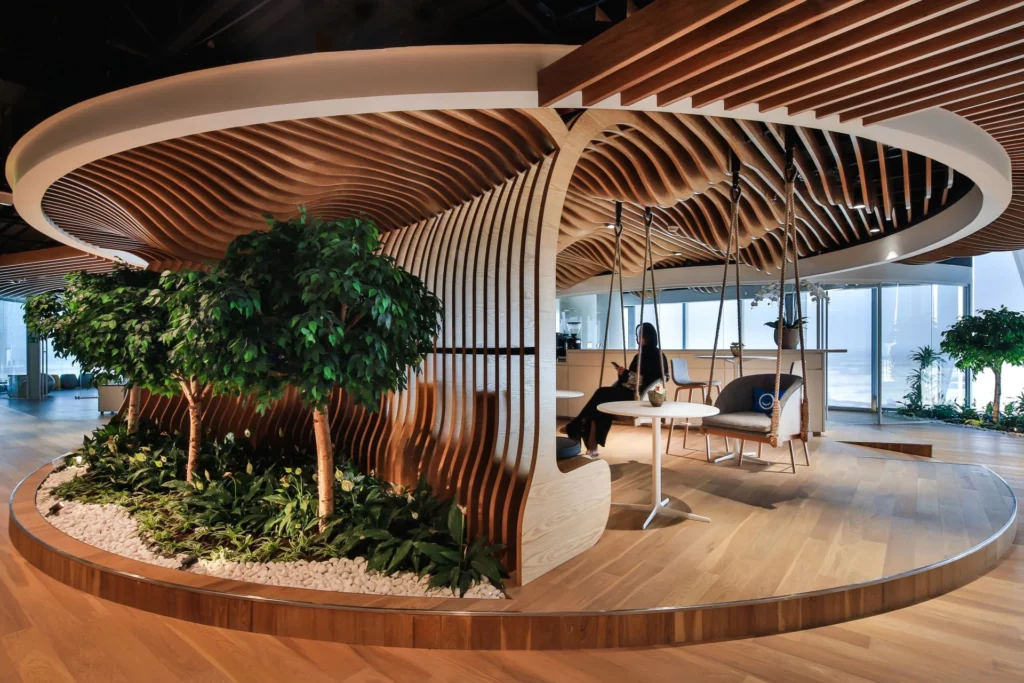
Ever since American biologist Edward O. Wilson postulated a scientific hypothesis on “Biophilia” in 1984, and long before that, nature has been an essential part of human life. Its positive impact on our physical and mental well-being has been extensively researched and our dependence on it reaches far more than the daily vegetables we eat or the trees that produce our oxygen.
In the past few years, architects and designers have embraced the concept of biophilic design, which aims to foster a stronger bond between humans and nature within constructed spaces. By seamlessly integrating natural elements into architecture, this approach enhances our connection with the natural world, ultimately benefiting the health and overall well-being of those who inhabit these spaces.
Biophilic design operates on the belief that humans possess an inherent affinity for nature, and integrating natural components into our living spaces can profoundly enhance our overall well-being. The core philosophy of biophilic design revolves around crafting built environments that emulate the natural world, with the objective of promoting positive effects on our physical, emotional, and cognitive health.
Elements of Biophilic Design
Biophilic design encompasses an array of design elements all ranging from access to nature to the usage of lights and natural lights. These elements are the building blocks of biophilic design, and can help to break the concept down into conceptual pieces.
- Use of natural materials
Biophilic design and architecture is all about incorporating nature into our daily environments which has been constantly modernised over the years. The usage and accommodation of natural materials such as wood, stone or bamboo into the design can manage to create a sense of warmth and comfort, and promote a connection with nature.
- Natural lighting
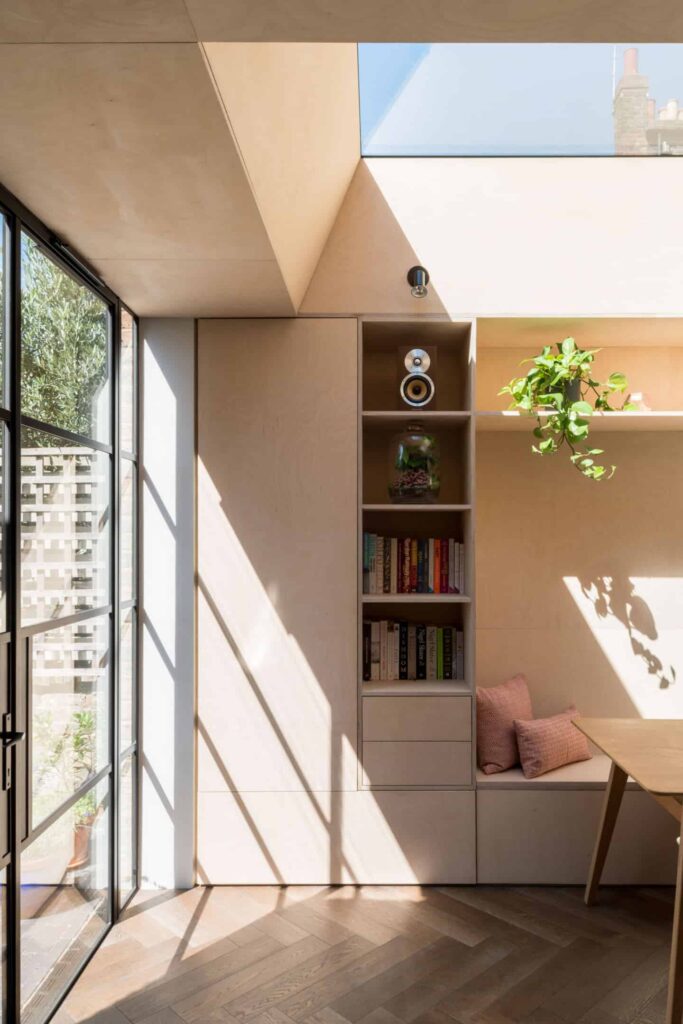
Lighting is one of the most important aspects of architecture, and is a key factor that can
either make or break a space. Maximising the usage of natural light through skylights, clerestory windows, or light shelves, can create a bright and healthy indoor environment that is also good for the eyes.
Natural lights also have a positive impact on our circadian rhythms, which can help to
improve sleep patterns and prompt overall physical and mental well-being. Furthermore, an increase in natural lights allows for less need of industrial, artificial lighting, thus reducing one’s energy usage and domestic footprint.
- Water bodies
Water is the world’s universal solvent and holds significant importance within biophilic design, as it possesses the power to induce a sense of tranquillity in individuals. Its auditory and visual qualities can mimic the soothing aspects of nature. By integrating water features into both indoor and outdoor spaces, architects and designers can establish therapeutic environments that effectively diminish stress levels and enhance overall well-being. Fountains, ponds, and pools are just a few examples of the diverse forms that water features can take in this context.
- Access to nature
By integrating elements like windows, balconies, or courtyards, architects and designers can incorporate direct or indirect views of nature into built environments, fostering a serene atmosphere and enhancing overall well-being. Access to nature can be facilitated through the usage of natural materials such as wood, stone, or water features, further contributing to a sense of tranquillity.
- Greenery
Plants and trees have been recognized for their ability to instil a sense of calmness in individuals and positively impact both physical and mental well-being. When incorporated into architectural designs, plants or green walls can enhance indoor air quality, alleviate stress, and create an environment that fosters tranquillity and overall well-being.
Benefits of Biophilic Design
The myriad of benefits that stem from biophilic design goes beyond our own individual health and well-being. This form of design can have a positive impact on the environment as well by promoting green architecture and sustainable living. Below are some examples of benefits brought by biophilic design:
- Better air quality
By integrating greenery and natural ventilation systems into indoor spaces, significant improvements can be made to the quality of the air we breathe. This, in turn, reduces the occurrence of respiratory illnesses and creates a healthier living environment. Greenery helps to purify and filter the air by absorbing pollutants and releasing oxygen, while natural ventilation systems facilitate the circulation of fresh air, preventing the buildup of harmful contaminants. The combination of these elements promotes a cleaner and healthier indoor atmosphere, benefiting the well-being of occupants.
- Reduced stress levels
Having access to nature and ample natural light has been found to have numerous positive effects on our well-being. It can effectively reduce stress levels, lower blood pressure, and contribute to an overall sense of improved physical and mental well-being. Being in proximity to natural elements and allowing natural light to permeate indoor spaces creates a soothing and calming environment that positively impacts our health and quality of life.
- Improved cognitive functions
Integrating natural elements into architectural designs can have a profound impact on cognitive function, creativity, productivity, and learning abilities. By incorporating natural materials, views of nature, and other biophilic design elements, spaces can stimulate cognitive processes, inspire creative thinking, increase productivity, and enhance concentration and learning capabilities.
Biophilic architecture plays a crucial role in promoting green living by advocating for sustainable practices. It encourages the utilisation of natural materials and the integration of green infrastructure, aligning with our need to address the challenges posed by a rapidly changing world. Embracing the principles of biophilic design becomes increasingly important as we strive to create a better future for ourselves, our communities, and the planet as a whole. By adopting these principles, we can foster a harmonious relationship between built environments and the natural world, ensuring a sustainable and resilient future.
Famous Examples of Biophilic Design
The practice of biophilic design and nature-connected structures is ever growing since the turn of the century with countless impressive examples across the globe.
- Khoo Teck Puat Hospital, Yishun, Singapore
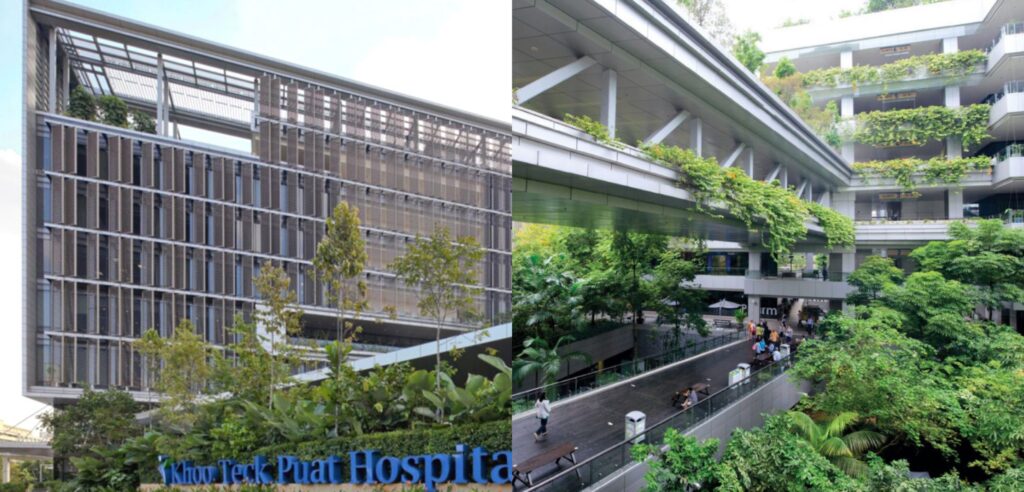
The Khoo Teck Puat Hospital in Yishun, Singapore, serves as a leading example of a well-established biophilic architecture that is benefiting its inhabitants and community. Winner of the Stephen R. Kellert Biophilic Design Award, this hospital promotes healing and wellbeing by interlacing a rainforest-like garden with the built environment.
Its intricate designs all serve to immerse patients and visitors in the hospital’s natural wonders, with the sky bridges capturing attention to the garden’s natural sights, sound and scents. Furthermore, the V-shaped configuration of north-facing blocks provides patients with natural light and breezes, which research shows can reduce blood pressure and heart rates and even shorten a patient’s length of stay.
- University of Melbourne Biosciences Building, Melbourne, Australia
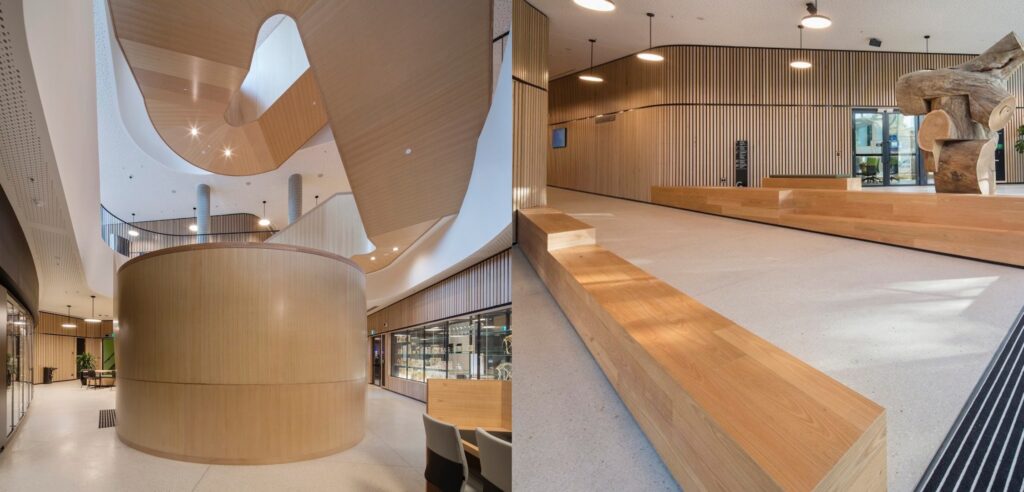
Designed by Hassell, the building aligns with one of its main design philosophies, which is to “continuously improve environmental performance and energy efficiencies as well as create healthier work environments.”
This example of biophilic architecture represents world leadership in environmentally sustainable building practices and is widely known as a six-star Green Star building. It features natural materials throughout its interiors including timber-lined walls and a striking curved wooden staircase. Lastly, with research, it can be shown that the use of biophilic design in a learning environment like the University of Melbourne, can boost creativity and improve cognitive performance and productivity.
- The Spheres, Seattle, USA

The Spheres in Seattle, USA was built in the heart of Seattle’s city-centre to give Amazon employees a calming retreat for reflection, respite and inspiration. Amazon created this oasis after recognising a lack of connection from nature in our urban environment. The two domes are home to more than 40,000 plants from 30 different countries, as well as gigantic living walls covering 4,000 square feet.
- Pasona Urban Farm, Tokyo, Japan
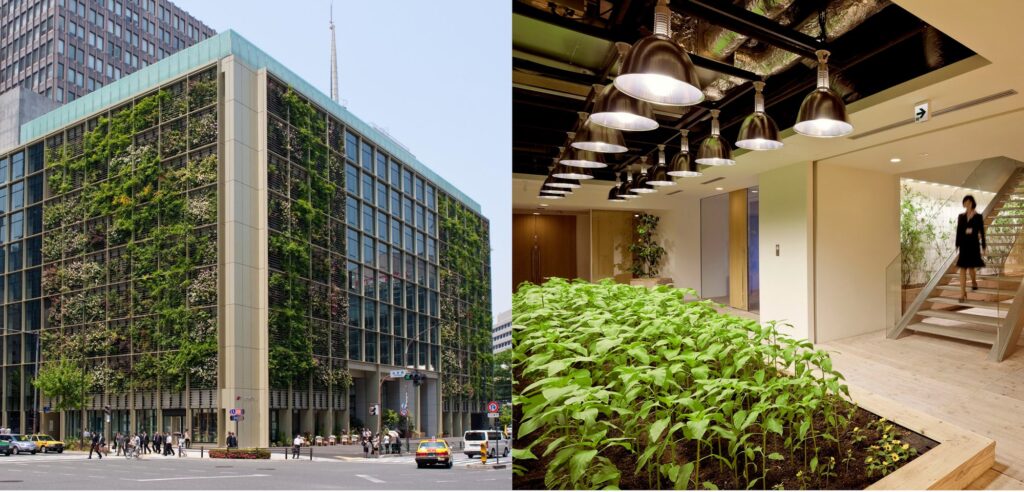
The Pasona Group, a human resources consulting company has its Tokyo headquarters located in a nine-story building with a rooftop garden and plants covering two of its external walls. Most notably, the headquarters also have urban farming facilities integrated into the offices with an astonishing 43,000 square feet of the building featuring 200 species including fruit, vegetables and rice which are harvested and used in the meals at the building’s cafeterias.
- The Metropol Parasol, Seville, Spain

The last example here of biophilic architecture is the Metropol Parasol from Seville, Spain. It acts as one of the largest wooden structures in the world, and has become a cultural landmark in Seville. The Metropol Parasol consists of six large mushroom-shaped timber parasols that protect an archaeological site and shade the Plaza de la Encarnación. Furthermore, the micro-laminated timber lattice creates interesting, artistic shadows that move throughout the day and a public balcony that offers beautiful, panoramic views of Seville’s old quarter.
Read on further!
Recently, Wesley Masters, the content writing specialist for Rent. – a subsidiary of the real estate powerhouse Redfin – has written a post on Rent.’s blog which features a quick contribution from me! She spoke of the history of biophilia as well as the realistic ways to channel nature in our spaces. It is highly encouraged to visit her work, especially after reading and finding interest in this topic.
Wesley’s article: Biophilic Interiors: Bringing Natural Elements Indoors.
Bibliography
- Chopra, Lavanya. “The Rise of Biophilic Design: Incorporating Nature into Modern Interiors.” Hipcouch | Complete Interiors & Furniture, 24 Feb. 2023, www.hipcouch.com/magazine/rise-biophilic-design-incorporating-nature-modern-interiors.
- Choudhury, Atreyee. “The Rise of Biophilic Design, Integrating Nature into Modern Architecture.” The Times of India, 15 June 2023, https://timesofindia.indiatimes.com/blogs/voices/the-rise-of-biophilic-design-integrating-nature-into-the-modern-architecture/?source=app&frmapp=yes.
- Gloede, Katie. “7 Ways to Enhance Indoor Environments with Biophilic Design.” Architectmagazine.com, 17 Feb. 2015, www.architectmagazine.com/technology/7-ways-to-enhance-indoor-environments-with-biophilic-design_o.
- Rahat, Sajid. “The Rise of Biophilic Design: Meeting Nature in Your Abode» Square Feet Story.” Square Feet Story, 13 Apr. 2023, https://squarefeetstory.com/the-rise-of-biophilic-design-meeting-nature-in-your-abode/
- Ridley, Rachael. “9 Amazing Buildings That Use Nature-Connected Design.” Planetark.org, 21 Sept. 2020, https://planetark.org/newsroom/news/9-amazing-buildings-that-use-nature-connected-design


